| [1] |
WANG FS, FAN JG, ZHANG Z, et al. The global burden of liver disease: the major impact of China[J]. Hepatology, 2014, 60( 6): 2099- 2108. DOI: 10.1002/hep.27406. |
| [2] |
Chinese Society of Hepatology, Chinese Medical Association. Guidelines on the diagnosis and management of autoimmune hepatitis(2021)[J]. J Clin Hepatol, 2022, 38( 1): 42- 49.
中华医学会肝病学分会. 自身免疫性肝炎诊断和治疗指南(2021)[J]. 临床肝胆病杂志, 2022, 38( 1): 42- 49.
|
| [3] |
Chinese Society of Hepatology, Chinese Medical Association. Guidelines on the diagnosis and management of primary biliary cholangitis(2021)[J]. J Clin Hepatol, 2022, 38( 1): 35- 41.
中华医学会肝病学分会. 原发性胆汁性胆管炎的诊断和治疗指南(2021)[J]. 临床肝胆病杂志, 2022, 38( 1): 35- 41.
|
| [4] |
Chinese Society of Hepatology, Chinese Medical Association. Guidelines on the diagnosis and management of primary sclerosing cholangitis(2021)[J]. J Clin Hepatol, 2022, 38( 1): 50- 61.
中华医学会肝病学分会. 原发性硬化性胆管炎诊断及治疗指南(2021)[J]. 临床肝胆病杂志, 2022, 38( 1): 50- 61.
|
| [5] |
Chinese Society of Infectious Diseases, Chinese Medical Association; Chinese Society of Hepatology, Chinese Medical Association. Guidelines for the prevention and treatment of chronic hepatitis B(version 2019)[J]. J Clin Hepatol, 2019, 35( 12): 2648- 2669. DOI: 10.3969/j.issn.1001-5256.2019.12.007. |
| [6] |
Chinese Society of Hepatology, Chinese Medical Association; Chinese Society of Infectious Diseases, Chinese Medical Association. Guidelines for the prevention and treatment of hepatitis C(2019 version)[J]. J Clin Hepatol, 2019, 35( 12): 2670- 2686. DOI: 10.3969/j.issn.1001-5256.2019.12.008. |
| [7] |
National Workshop on Fatty Liver and Alcoholic Liver Disease, Chinese Society of Hepatology, Chinese Medical Association; Fatty Liver Expert Committee, Chinese Medical Doctor Association. Guidelines of prevention and treatment for nonalcoholic fatty liver disease: A 2018 update[J]. J Clin Hepatol, 2018, 34( 5): 947- 957. DOI: 10.3969/j.issn.1001-5256.2018.05.007. |
| [8] |
Fatty Liver Expert Committee, Chinese Medical Doctor Association; National Workshop on Fatty Liver and Alcoholic Liver Disease, Chinese Society of Hepatology, Chinese Medical Association. Guidelines of prevention and treatment for alcoholic liver disease: a 2018 update[J]. J Clin Hepatol, 2018, 34( 5): 939- 946. DOI: 10.3969/j.issn.1001-5256.2018.05.006. |
| [9] |
Chinese Medical Association, Chinese Medical Journals Publishing House, Chinese Society of Gastroenterology, et al. Guidelines for the diagnosis and treatment of drug-induced liver injury(2019)[J]. Chin J Gen Pract, 2020, 19( 10): 868- 875. DOI: 10.3760/cma.j.cn.114798-20200812-00900. |
| [10] |
Chinese Society of Hepatology, Chinese Medical Association. Chinese guidelines on the management of liver cirrhosis[J]. J Clin Hepatol, 2019, 35( 11): 2408- 2425. DOI: 10.3969/j.issn.1001-5256.2019.11.006. |
| [11] |
Liver Failure and Artificial Liver Group, Chinese Society of Infectious Diseases, Chinese Medical Association; Severe Liver Disease and Artificial Liver Group, Chinese Society of Hepatology, Chinese Medical Association. Guideline for diagnosis and treatment of liver failure(2018)[J]. J Clin Hepatol, 2019, 35( 1): 38- 44. DOI: 10.3969/j.issn.1001-5256.2019.01.007. |
| [12] |
LUO QM, CHEN J, LI ZP, et al. Recent advances in antiviral therapy for chronic hepatitis B[J]. Guangdong Med J, 2022, 43( 7): 843- 848. DOI: 10.13820/j.cnki.gdyx.20222141. |
| [13] |
SHAN S, JIA JD. Achievements in the prevention and control of chronic viral hepatitis B in the past decade[J]. Chin J Clin, 2022, 50( 10): 1131- 1132. DOI: 10.3969/j.issn.2095-8552.2022.10.001. |
| [14] |
LANCASTER K, RHODES T, RANCE J. Towards eliminating viral hepatitis: Examining the productive capacity and constitutive effects of global policy on hepatitis C elimination[J]. Int J Drug Policy, 2020, 80: 102419. DOI: 10.1016/j.drugpo.2019.02.008. |
| [15] |
ZHENG E, SANDHU N, NAVARRO V. Drug-induced liver injury secondary to herbal and dietary supplements[J]. Clin Liver Dis, 2020, 24( 1): 141- 155. DOI: 10.1016/j.cld.2019.09.009. |
| [16] |
SHEN T, LIU Y, SHANG J, et al. Incidence and etiology of drug-induced liver injury in mainland China[J]. Gastroenterology, 2019, 156( 8): 2230- 2241. e 11. DOI: 10.1053/j.gastro.2019.02.002. |
| [17] |
GREWAL P, AHMAD J. Severe liver injury due to herbal and dietary supplements and the role of liver transplantation[J]. World J Gastroenterol, 2019, 25( 46): 6704- 6712. DOI: 10.3748/wjg.v25.i46.6704. |
| [18] |
NAVARRO V, AVULA B, KHAN I, et al. The contents of herbal and dietary supplements implicated in liver injury in the united states are frequently mislabeled[J]. Hepatol Commun, 2019, 3( 6): 792- 794. DOI: 10.1002/hep4.1346. |
| [19] |
de ABAJO FJ, MONTERO D, MADURGA M, et al. Acute and clinically relevant drug-induced liver injury: a population based case-control study[J]. Br J Clin Pharmacol, 2004, 58( 1): 71- 80. DOI: 10.1111/j.1365-2125.2004.02133.x. |
| [20] |
VEGA M, VERMA M, BESWICK D, et al. The incidence of drug- and herbal and dietary supplement-induced liver injury: preliminary findings from gastroenterologist-based surveillance in the population of the state of delaware[J]. Drug Saf, 2017, 40( 9): 783- 787. DOI: 10.1007/s40264-017-0547-9. |
| [21] |
SHEN Q, WANG XP, QIANG L. Research progress on the pathogenesis of drug-induced liver injury caused by different drugs[J]. J Pharm Res, 2022, 41( 9): 595- 599. DOI: 10.13506/j.cnki.jpr.2022.09.007. |
| [22] |
Chinese Medical Association, Chinese Medical Association, Publishing House Gastroenterology Branch of Chinese Medical Association, et al. Guidelines for the primary diagnosis and treatment of alcoholic liver disease(2019)[J]. Chin J Gen Pract, 2020, 19( 11): 990- 996. DOI: 10.3760/cma.j.cn114798-20200812-00898. |















 DownLoad:
DownLoad:



